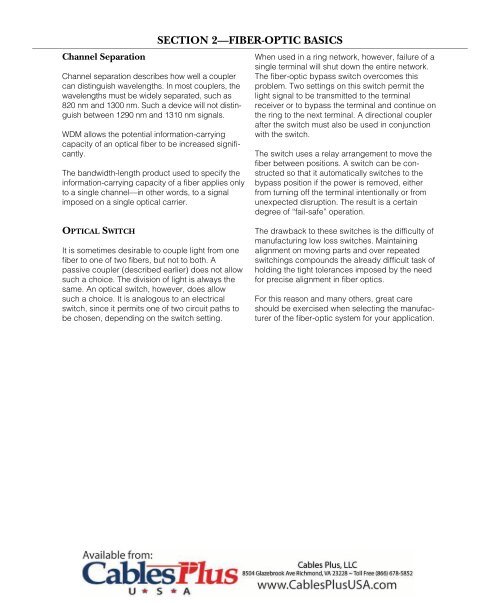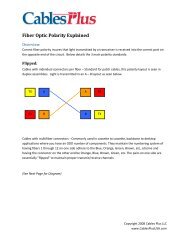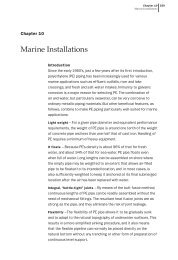Learning About Options in Fiber - Cables Plus USA
Learning About Options in Fiber - Cables Plus USA
Learning About Options in Fiber - Cables Plus USA
You also want an ePaper? Increase the reach of your titles
YUMPU automatically turns print PDFs into web optimized ePapers that Google loves.
Channel Separation<br />
Channel separation describes how well a coupler<br />
can dist<strong>in</strong>guish wavelengths. In most couplers, the<br />
wavelengths must be widely separated, such as<br />
820 nm and 1300 nm. Such a device will not dist<strong>in</strong>guish<br />
between 1290 nm and 1310 nm signals.<br />
WDM allows the potential <strong>in</strong>formation-carry<strong>in</strong>g<br />
capacity of an optical fiber to be <strong>in</strong>creased significantly.<br />
The bandwidth-length product used to specify the<br />
<strong>in</strong>formation-carry<strong>in</strong>g capacity of a fiber applies only<br />
to a s<strong>in</strong>gle channel—<strong>in</strong> other words, to a signal<br />
imposed on a s<strong>in</strong>gle optical carrier.<br />
SECTION 2—FIBER-OPTIC BASICS<br />
When used <strong>in</strong> a r<strong>in</strong>g network, however, failure of a<br />
s<strong>in</strong>gle term<strong>in</strong>al will shut down the entire network.<br />
The fiber-optic bypass switch overcomes this<br />
problem. Two sett<strong>in</strong>gs on this switch permit the<br />
light signal to be transmitted to the term<strong>in</strong>al<br />
receiver or to bypass the term<strong>in</strong>al and cont<strong>in</strong>ue on<br />
the r<strong>in</strong>g to the next term<strong>in</strong>al. A directional coupler<br />
after the switch must also be used <strong>in</strong> conjunction<br />
with the switch.<br />
The switch uses a relay arrangement to move the<br />
fiber between positions. A switch can be constructed<br />
so that it automatically switches to the<br />
bypass position if the power is removed, either<br />
from turn<strong>in</strong>g off the term<strong>in</strong>al <strong>in</strong>tentionally or from<br />
unexpected disruption. The result is a certa<strong>in</strong><br />
degree of “fail-safe” operation.<br />
OPTICAL SWITCH<br />
It is sometimes desirable to couple light from one<br />
fiber to one of two fibers, but not to both. A<br />
passive coupler (described earlier) does not allow<br />
such a choice. The division of light is always the<br />
same. An optical switch, however, does allow<br />
such a choice. It is analogous to an electrical<br />
switch, s<strong>in</strong>ce it permits one of two circuit paths to<br />
be chosen, depend<strong>in</strong>g on the switch sett<strong>in</strong>g.<br />
The drawback to these switches is the difficulty of<br />
manufactur<strong>in</strong>g low loss switches. Ma<strong>in</strong>ta<strong>in</strong><strong>in</strong>g<br />
alignment on mov<strong>in</strong>g parts and over repeated<br />
switch<strong>in</strong>gs compounds the already difficult task of<br />
hold<strong>in</strong>g the tight tolerances imposed by the need<br />
for precise alignment <strong>in</strong> fiber optics.<br />
For this reason and many others, great care<br />
should be exercised when select<strong>in</strong>g the manufacturer<br />
of the fiber-optic system for your application.<br />
2-27
















